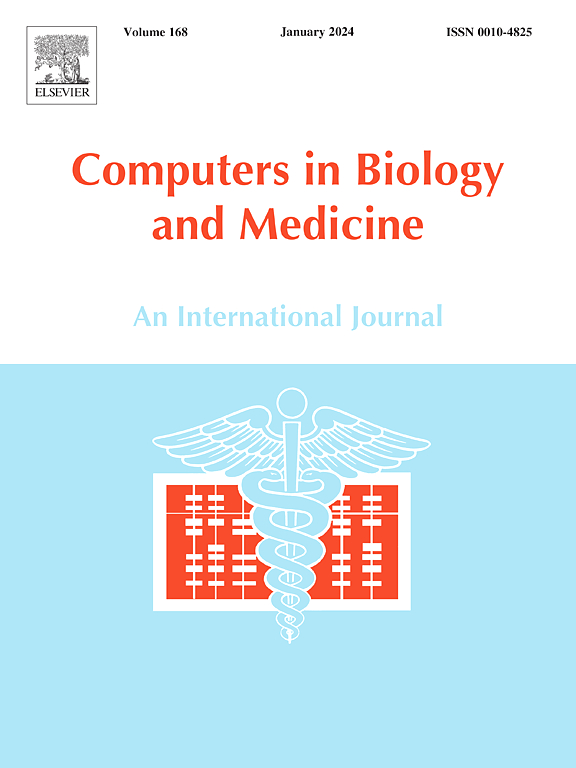医学成像中高斯-泊松混合噪声的频率-空间混合无监督去噪模型
IF 7
2区 医学
Q1 BIOLOGY
引用次数: 0
摘要
本文提出了一种无监督去噪模型,用于处理CT、MRI和x射线图像中的高斯-泊松混合噪声。传统的深度图像先验(DIP)方法存在收敛速度慢、光谱偏倚和过拟合等问题,限制了其临床应用。在本文中,通过应用傅里叶变换,我们在输入阶段结合从观察到的噪声图像中提取的频域先验。我们没有同时使用振幅和相位,而是完全依赖于振幅谱,它捕获了各种频率分量的能量分布,同时避免了与相位信息相关的不稳定性。同时,我们保留了空间域信息,保持了图像的结构完整性,确保了低频细节和高频解剖特征的有效捕获。这种双域策略允许在训练早期捕获精细细节,从而减轻光谱偏差,加速收敛,并改善高频解剖结构的保存。为了进一步提高诊断保真度,我们用边缘感知L1损失函数取代了传统的均方误差(MSE)损失,该函数更好地保留了关键的解剖纹理。此外,基于熵的准则跟踪迭代过程中图像不确定性的变化,以确定最佳停止点,在不需要外部验证数据的情况下有效地防止过拟合。实验结果表明,与DIP相比,我们的模型的PSNR平均提高了10.7%,SSIM平均提高了17.9%,仅在60次迭代中达到峰值性能,比DIP和DIP- aitv分别需要1360和2990次迭代更快。这些发现突出了我们的方法对医学图像去噪的效率和有效性。本文章由计算机程序翻译,如有差异,请以英文原文为准。
A hybrid frequency-spatial domain unsupervised denoising model for Gaussian-Poisson mixed noise in medical imaging
This paper proposes an unsupervised denoising model designed to address Gaussian-Poisson hybrid noise in CT, MRI, and X-ray images. Traditional deep image prior (DIP) methods suffer from slow convergence, spectral bias, and overfitting, limiting their clinical applicability. In this paper, by applying the Fourier transform, we incorporate frequency-domain priors extracted from the observed noisy image at the input stage. Instead of using both amplitude and phase, we rely solely on the amplitude spectrum, which captures the energy distribution of various frequency components while avoiding the instability associated with phase information. Meanwhile, we retain the spatial domain information to preserve the image's structural integrity, ensuring the effective capture of both low-frequency details and high-frequency anatomical features. This dual-domain strategy allows fine details to be captured early in training, thereby mitigating spectral bias, accelerating convergence, and improving the preservation of high-frequency anatomical structures. To further enhance diagnostic fidelity, we replace the conventional mean squared error (MSE) loss with an edge-aware L1 loss function that better preserves critical anatomical textures. Additionally, an entropy-based criterion tracks variations in image uncertainty over iterations to determine the optimal stopping point, effectively preventing overfitting without the need for external validation data. Experimental results demonstrate that our model achieves an average improvement of 10.7 % in PSNR and 17.9 % in SSIM compared to DIP, reaching peak performance in just 60 iterations, faster than the 1360 and 2990 iterations required by DIP and DIP-AITV, respectively. These findings highlight the efficiency and effectiveness of our method for medical image denoising.
求助全文
通过发布文献求助,成功后即可免费获取论文全文。
去求助
来源期刊

Computers in biology and medicine
工程技术-工程:生物医学
CiteScore
11.70
自引率
10.40%
发文量
1086
审稿时长
74 days
期刊介绍:
Computers in Biology and Medicine is an international forum for sharing groundbreaking advancements in the use of computers in bioscience and medicine. This journal serves as a medium for communicating essential research, instruction, ideas, and information regarding the rapidly evolving field of computer applications in these domains. By encouraging the exchange of knowledge, we aim to facilitate progress and innovation in the utilization of computers in biology and medicine.
 求助内容:
求助内容: 应助结果提醒方式:
应助结果提醒方式:


